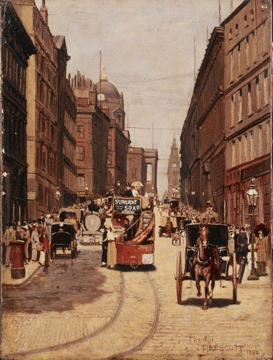End of the Line

New display at the Museum of Liverpool marks the 60th anniversary of the last tram parade in the city
A new exhibition featuring more than 30 photographs of Liverpool trams opens at the Museum of Liverpool on Thursday 14 September 2017, 60 years to the date of the city’s last tram parade.
End of the Line also includes a display of related objects such as models, tickets, posters, plans, buttons and badges.
A highlight of the exhibition is an image of Tramcar 245, the only surviving Liverpool Baby Grand Tramcar in the UK and part of National Museums Liverpool’s (NML) collections. 245 was restored in partnership with NML, Merseyside Tramway Preservation Society and Wirral Borough Council, and the image shows the tram in all her glory with a number of the volunteers who worked on her transformation.
Sharon Brown, Curator of Land Transport and Industry at the Museum of Liverpool said:
“There were trams on the streets of Liverpool for almost 100 years. As the city’s first public transport system it had an important role to play in the business and development of the city. At its peak the tram network stretched to all corners of the city.
“The collection of photographs will bring back fond memories of the trams as well as a fascinating look at how some of Liverpool’s most iconic streets have changed.”
To mark the anniversary of the last tram parade, the Museum of Liverpool will be hosting free of events on Saturday 16 September, including a display of tram models and family craft activities. Talks include:
1pm - Sharon Brown, Curator of Land Transport & Industry will be giving a talk about the restoration of Tramcar 245.
1.30pm - Rob Jones from the Merseyside Tramway Preservation Society, based at the Wirral Transport Museum will be giving a talk on the work of Merseyside Tramway Preservation Society in restoring numerous tramcars to run on the Birkenhead Heritage Tramway.
2.30pm - Geoff Price from the Tram and Light Railway Society (Merseyside Branch) is a self-confessed tram enthusiast and will talk about aspects of the Liverpool Tramway.
www.liverpoolmuseums.org.uk/liverpooltrams
Notes to editors
Museum of Liverpool
The Museum of Liverpool is one of the country’s most visited museums outside of London. It is the largest newly-built national museum in Britain for more than a century, demonstrating Liverpool’s unique contribution to the world. The first national museum devoted to the history of a regional city, it showcases popular culture while tackling social, historical and contemporary issues. It has attracted more than two million visitors since opening in July 2011. The prestigious Council of Europe Museum Prize for 2013 was awarded to the Museum for its commitment to human rights as well as its work with children and families from all backgrounds.
The Museum has received generous support from several major funders, and grants from trusts and foundations, corporate support and individual donations. Major funders include the Northwest Regional Development Agency (NWDA), The European Regional Development Fund (ERDF), the Heritage Lottery Fund (HLF), the Department for Culture Media and Sport (DCMS),Garfield Weston Foundation and the Clore Duffield Foundation.
The Northwest Regional Development Agency (NWDA) was responsible for the sustainable economic development and regeneration of England’s Northwest and had five key priorities: Business, Skills and Education, People and Jobs, Infrastructure and Quality of Life.
The European Development Fund (ERDF) is making a real difference to people and businesses in the North West. With €755 million to invest between 2007 and 2013, ERDF is enhancing the competitiveness of the region’s economy by supporting growth in enterprise and employment. ERDF in the North West is managed by the Department for Communities and Local Government – for further information visit www.communities.gov.uk/erdf.
Using money raised through the National Lottery, the Heritage Lottery Fund (HLF) sustains and transforms a wide range of heritage for present and future generations to take part in, learn from and enjoy. From museums, parks and historic places to archaeology, natural environment and cultural traditions, we invest in every part of our diverse heritage. HLF has supported more than 30,000 projects allocating £4.5billion across the UK.
About National Museums Liverpool
National Museums Liverpool comprises eight venues, including some of the most visited museums in England outside of London. Our collections are among the most important and varied in Europe and contain everything from Impressionist paintings and rare beetles to a lifejacket from the Titanic. We attract more than 3 million visitors every year. Our venues are the Museum of Liverpool, World Museum, the Walker Art Gallery, Merseyside Maritime Museum, International Slavery Museum, Border Force National Museum, Sudley House and the Lady Lever Art Gallery.
